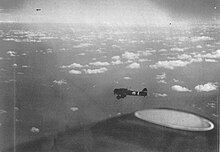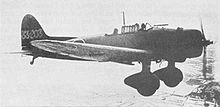
Back Aichi D3A Afrikaans إيشي دي3إيه Arabic Аичи D3A Bulgarian Aichi D3A Catalan Aiči D3A Czech Aichi D3A German Aichi D3A Greek Aichi D3A Spanish بمبافکن هواپیمابر نوع ۹۹ Persian Aichi D3A Finnish
| D3A | |
|---|---|

| |
| Aichi D3A1 from carrier Akagi. | |
| Role | Carrier-based dive bomber |
| Manufacturer | Aichi Kokuki KK |
| First flight | January 1938 |
| Introduction | 1940[1] |
| Retired | 1945 |
| Primary user | Imperial Japanese Navy Air Service |
| Number built | 1,495 (479 D3A1) (1016 D3A2) |
| Developed into | Yokosuka D3Y Myōjo |







The Aichi D3A (Navy designation "Type 99 Carrier Bomber"; Allied reporting name "Val")[a] is a World War II carrier-borne dive bomber. It was the primary dive bomber of the Imperial Japanese Navy (IJN) and was involved in almost all IJN actions, including the attack on Pearl Harbor.
The Aichi D3A was the first Japanese aircraft to bomb American targets in the war, commencing with Pearl Harbor and U.S. bases in the Philippines, such as Clark Air Force Base. They sank more Allied warships than any other Axis aircraft.[2][3][4]
- ^ Chant 1999, p. 16.
- ^ Angelucci & Matricardi 1978, p. 142.
- ^ Worth 2001, p. 170.
- ^ Casey 1977, p. 87.
Cite error: There are <ref group=lower-alpha> tags or {{efn}} templates on this page, but the references will not show without a {{reflist|group=lower-alpha}} template or {{notelist}} template (see the help page).
© MMXXIII Rich X Search. We shall prevail. All rights reserved. Rich X Search